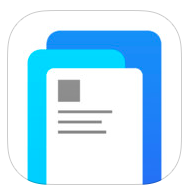
Yesterday Facebook released Paper, a new stand-alone app to browse content. Paper represents a dramatic departure from Facebook as a place to connect with your friends. Paper aims to connect users with the rest of the world. It’s also the first step towards Facebook becoming a media company.
Your Friends – Just a Channel
Paper is what happens when companies think about what their product would look like if they started over. It’s not your news feed.
Paper’s overall design is impressive. From how it looks, to how it feels to use, Paper is great. Especially in the touch sensitivity. Paper just feels easy to physically navigate; effortless and fun.
In terms of the content, it’s separated into curated channels. One of which is aptly entitled “Facebook”.
Other channels include Ideas, Tech, Creators, Flavor, and the like – all topical and curated. I like how the channel selection is limited.
(If you think about how TV became adopted by the masses, it started with only a few channels in the form of CBS, NBC, and ABC. Cable and the hundreds of channels we have didn’t come until MUCH later. Why run before you know how to walk? I’m looking at you, Twitter!)
The content in the channels come in the form of a lead story and then a set of cards below which can be swiped upward to expose the full story. From there people can comment, like, share, save to a reading list, copy link, or follow/hide/report the “post”. RSS lives!
Bold Departure from the Past
This app was the product of months, if not years, of work and persuasion at Facebook HQ. In December of 2013 AllThingsD wrote an in-depth story on the internal struggles at FB over a project to make the “ideal” News Feed.
That was Paper.
Certain people within Facebook (the sources for the article) were not happy that Facebook, and not Facebook users, were deciding what content would show up in the news feed. It smacked of elitism.
Facebook leadership was steadfast in taking a more curated approach to the news feed –
The overall goal here: Cox and Zuckerberg, the two most vocal proponents of this philosophy, want visiting the site to be a “useful” experience, delivering a well-rounded assortment of content for people across the world, in a tight, well-crafted package.
Any major new product from FB that isn’t based on the social news feed is going to be disruptive to the company. People feel threatened.
As tech companies grow, they oftentimes create a separate Labs team (like Google X or the original Macintosh team) to work on disruptive projects in peace.
Now we know that Paper was made by an internal Facebook group known as the “Creative Labs.”
Content Consumption vs. Creation
Facebook markets Paper as a tool for both reading and sharing, but if you ask me strategically Paper is all about content consumption and the ad dollars that come with it.
True, the core Facebook features for messaging, notifications, and friend requests are part of Paper. These are things you have to do at Facebook even if you’re in Creative Labs.
But if you look at the amount of the app design that is devoted to consumption vs. posting, the focus is on consumption. Which makes sense given that Pew released a report showing that the Facebook feed is dominated by a group of “super sharers” –
Of Facebook’s more than 1.2 billion users, only 10% update their status daily, while only 4% update it more than once a day, according to the Pew survey. About 15% of users comment on photos more than once a day.
Maybe Facebook users share less as they get older? Any trend towards less sharing is evidence of decreasing engagement from teenagers and younger people in general. Says Chris Cox, Vice President for product at Facebook –
“Facebook is not the container for articles and content. It’s really just a pointer, we’re not trying to get into the business of writing articles and creating content.”
Interesting phrasing. True, curation is not creating or writing. But it is deciding what users see, which is a departure from your friends (and a little Facebook) being the curators of your new feed.
(The inclusion of a Read Later setting that lets users connect 3rd party “read later” services further suggests a focus on consumption. These services allow users to save an article they find in Paper for later reading.)

A Threat to Twitter
If this is a threat to anyone, it’s most certainly Twitter. As Jean-Louise Gassée wrote in a recent Monday Note –
Twitter is fantastic in broadcast mode, but terrible in consumption mode
Many would agree that consumption on Twitter is broken. You choose who to follow and are then inundated with a stream of their updates. This is driving up America’s collective blood pressure.
Twitter has been slowly curating the timeline to include trending topics/tweets as well as more ads but there’s much work to be done. Perhaps more importantly, they can expect an outcry from power-users who are averse to any big changes in their Twitter timeline. (That’s the real challenge. Time for Twitter Labs…)
Paper is strong where Twitter is weak – on reading. Consider that Twitter’s market cap is $34.6B. This valuation is largely based on the same core competency as Facebook’s – mobile advertising.
Can you smell an opportunity for Facebook?
App Discovery
One last observation – it was downright difficult to find Paper in the App Store! This shows you that even when a major company like Facebook launches a new app, they have a hard time making it visible in the App Store. I found Paper using web search. I’m still waiting for the day when app discovery becomes as good as web content discovery…


{ 1 trackback }
{ 0 comments… add one now }